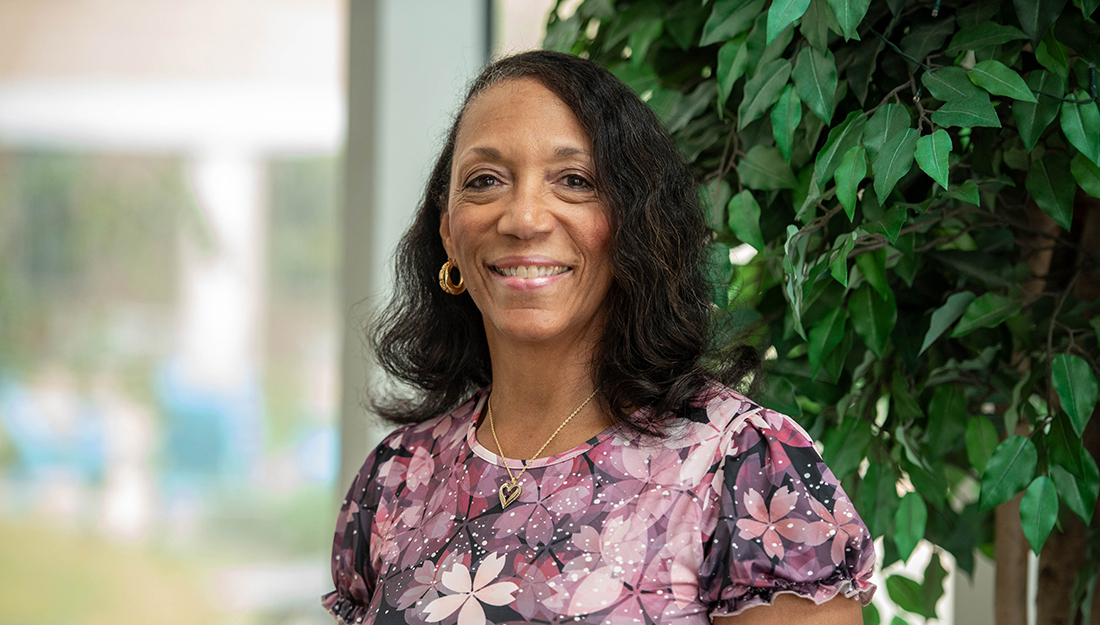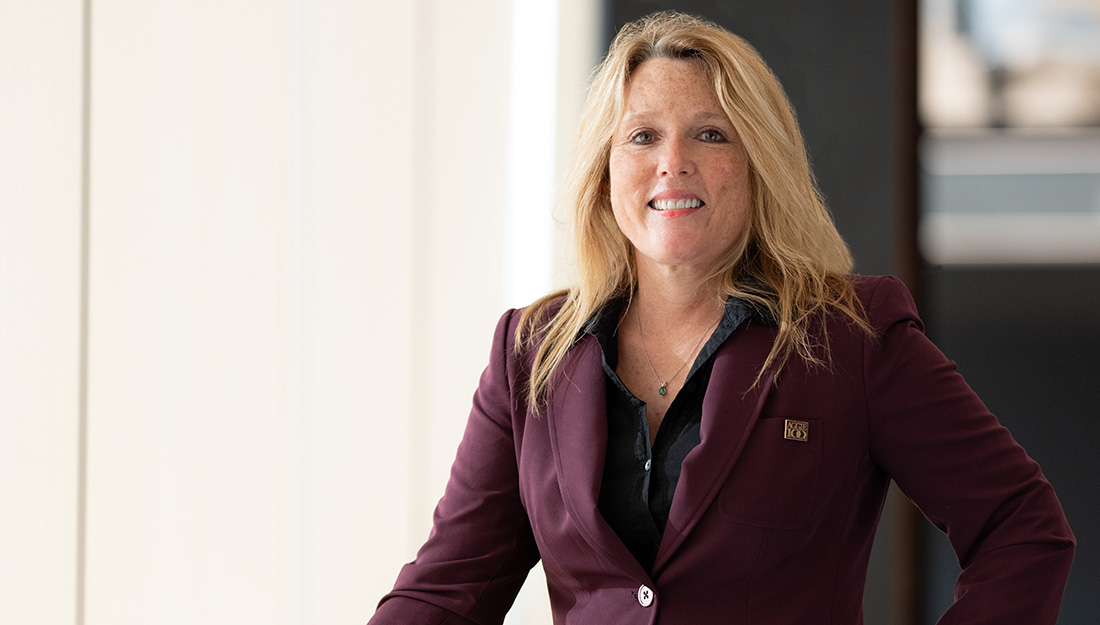- Katherine Hancock
- Giving, Medicine, Show on VR homepage
Introducing the physicianeers
The Denise Byington ’86 and Caroline Garcia Endowment will help support the future of Engineering Medicine

When Alonzo “Al” Byington ’58 knocked on a stranger’s door in 1985, he had no way of knowing that he was about to come face-to-face with his future son-in-law.
Al was in the process of helping his daughter, Carrie Byington ’85, move to Houston to begin medical school. Her new next-door neighbor, Humberto “Bert” Garcia ’81, was a young Texaco petroleum engineer.
It was Saturday and kick-off time for the Texas A&M University football game. Carrie’s television was not yet hooked up. Bert had both a sticker on his car announcing his Aggie affiliation and a functioning television. Al was desperate.
When Bert answered the door, Al asked him if he was watching the game and then asked to join him. After settling himself in Bert’s living room, Al then asked Bert for a beer.
The two became fast friends.
As neighbors, Carrie and Bert likewise became close friends. But it was her younger sister, Denise Byington ’86, who would marry him.
Thirty-three years later, the seeds planted with that knock on the door have culminated in a way that neither the Byingtons nor Bert could have imagined: a planned gift to the Texas A&M Foundation. The Denise Byington ’86 and Caroline Garcia Endowment will support EnMed, a revolutionary Texas A&M initiative that will allow medical students to simultaneously earn Doctor of Medicine and Master of Engineering degrees in four years.
The gift reflects the faith that Denise and her daughter, Caroline Garcia, place in the initiative’s potential to change the face of health care. But it also reflects their love for the three people who came together on a Texas A&M game day in 1985.
A year of change
In 2016, Carrie was a pioneering medical practitioner and teacher in Salt Lake City, intent on transforming the face of health care. Then Texas A&M came calling, providing her not only with a chance to move back home, but also to achieve this transformation by building upon the already-existent interprofessional partnerships among Texas A&M University Health Science Center components.
In January 2017, Carrie became vice chancellor for health services of The Texas A&M University System, senior vice president of the Texas A&M Health Science Center and dean of the Texas A&M College of Medicine.
Sadly, Bert wasn’t there to celebrate, having succumbed to pancreatic cancer just four months earlier. “My husband was so pleased and proud of Carrie when she moved from Utah back to Texas A&M,” Denise said. “He was so excited for her in seeing this dream come true, but sad that he wouldn’t be around to see it all take shape.”
The same year she lost her father, Caroline—Denise and Bert’s only child—graduated from The University of Texas at Austin and moved back to Houston, where she is a health and benefits consultant. Denise is a former equity trader. Their decision to support EnMed was not based on their own professional and academic backgrounds, but instead their reasons reflect both events of the last few years and their hopes for the future of health care.
Reason no. 1: the EnMed initiative
Texas A&M’s EnMed initiative is expected to be the largest engineering-based medical degree program in the nation. It is the result of a collaboration between Texas A&M’s colleges of medicine and engineering and Houston Methodist Hospital, and is overseen by Roderic I. Pettigrew, CEO of Engineering Health (EnHealth) and executive dean for EnMed at Texas A&M. This coming summer, students admitted to Texas A&M’s medical school can select the EnMed track, which will prepare them to be “physicianeers”—both practicing physicians and trained engineers.
In addition to the standard educational and research medical curriculum, EnMed students will focus on innovation and entrepreneurship. Along with their academic and professional requirements, these students must invent something to transform health care as a graduation stipulation. This technological “something” might involve a new way to treat or manage a disease, a way to use existing technology like cell phones to provide health care benefits, or a way to remotely provide health care to those living in rural areas or serving in the military. The possibilities are endless.
“It’s an innovative concept to take engineering and apply it to the medical field,” Denise said. “Combining the two will have such a beneficial impact on the future of medicine.”
Caroline said that as much as the EnMed program will mean to Texas A&M, she prefers to look at the “big picture” of how the medicine-engineering combination could positively impact health care overall. “I hope that if Texas A&M’s EnMed program is successful, it will inspire other schools to start similar programs, too,” she said.
Reason no. 2: Dr. Carrie Byington and Bert
The EnMed degree program was the brainchild of leaders at Texas A&M, including Dr. Byington and Dr. M. Katherine Banks, Texas A&M vice chancellor and dean of engineering. In addition to supporting such a transformative initiative, Denise sees her gift as a way of honoring her sister, who she proudly said is “doing amazing work at Texas A&M’s medical school and in health sciences in general.”
Denise said she is also honoring her husband with this gift—a man who majored in civil engineering, began his career as a petroleum engineer, and ended his career as a safety and environmental engineer. “I know my husband would be thrilled to see this kind of innovation,” she said. “To see how engineering could be applied in medicine would have been fascinating to him. For me, this gift was a very easy decision.”
Reason no. 3: Caroline
Bert and Denise were true believers in the power of philanthropy. Before Bert passed away, the couple funded endowed scholarships through the Texas A&M Foundation for both engineering students (his major) and business students (her major). This time, Denise opted to benefit Texas A&M by naming the Foundation as the beneficiary of her retirement account. She found this an easy and affordable way to give, as the funds will not be transferred until after her lifetime.
Because the Foundation will eventually receive Denise’s IRA funds, Caroline will not. So before Denise made her final decision, she discussed it with her daughter. Caroline readily agreed to sacrifice this future inheritance to support what she deemed “a really worthy cause.”
Caroline Garcia believes in the promise of the EnMed initiative on health care and hopes those in the program will develop technology to help in the fight against cancer—the disease that claimed her father.
Like her mother, Caroline believes in the promise of the EnMed initiative on health care overall. On a more personal level, she hopes those in the program will develop technology to help in the fight against cancer—the disease that claimed her father.
Including Caroline in the gift process, Denise said, was yet another way to honor Bert. “I put Caroline’s name on the endowment because she’s my husband’s only child,” Denise explained. “I want her to see this example of philanthropy and to understand the importance of giving back.”
Supporting the future of EnMed
No one is more moved by Denise and Caroline’s support of the EnMed initiative than Dr. Byington, one of the initiative’s co-creators.
“This gift is special to me for many reasons,” she said. “This endowment reflects the generosity and unconditional love of our family. The gift honors Humberto Garcia, a beloved husband, father and member of our family. Bert was a loyal Aggie and an engineer, and this gift recognizes both of these qualities.
“I had the opportunity to talk with Bert about the possibility of engineering medicine, and I know he recognized the potential for physicianeers to transform the field of medicine,” she added. “I believe he would be so proud of Denise and Caroline and happy to be supporting the future of EnMed.”
This article, written by Kara Bounds Socol, originally appeared on the Texas A&M Foundation’s website.
Media contact: media@tamu.edu


